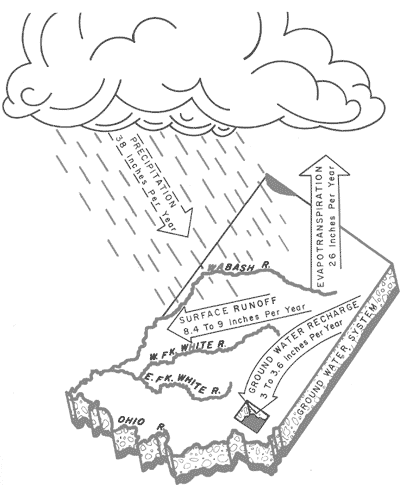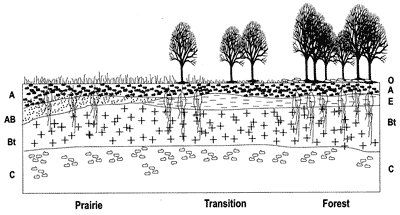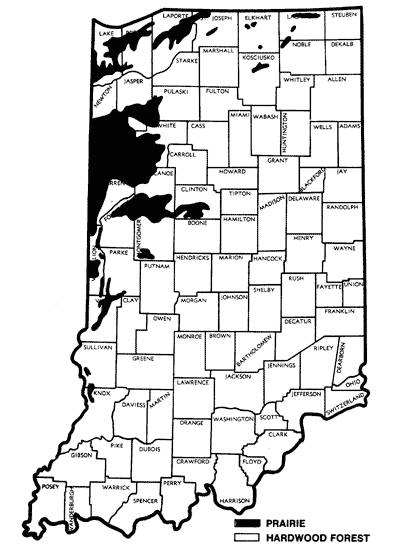I. SOIL FORMATION
Factors of Soil Formation Next Section>>
Characteristics of a soil are determined by five factors of soil formation:
- the composition of the parent material—the material from which the soil formed;
- the climate under which the soil formed;
- the organisms or plant and animal life on and in the soil;
- the relief or shape of the land surface; and
- the length of time the forces of soil formation have been acting on the soil material.
Parent material and topography are the factors of soil formation present when the soil starts to develop. Climate and plant and animal life then act on these initial conditions to cause formation of soil horizons. Finally, time is needed for changing parent material into soil.
A soil profile, as seen in a road cut or pit, is a vertical exposure of the various horizons or layers, including the topsoil, subsoil and substratum or undeveloped parent material. Distinct soil horizons develop as a result of the influence of these five soil formation factors. This usually takes hundreds or thousands of years.
Subsections: Parent Material | Relief | Climate | Organisms | Time
Parent Material
The parent material is the starting point in soil formation. It largely determines
the range of texture (i.e., percent composition of sand, silt, and clay) that
a soil will have. Its initial chemical and mineralogical properties will affect
the natural fertility of the soil formed.
Indiana soils have many kinds of parent material. They include material that
weathered from bedrock and mainly stayed in place and material that was carried
some distance by ice, water, or wind. Glaciers (large ice sheets) transported
the parent materials of many Indiana soils. The map of the soil regions of
Indiana, Fig. 1, is based mainly on soil parent material. Guidelines for identifying
rocks and parent materials are in Chapter II, Soil and Landscape Properties.
Before the glacial period, the topography of the state was rather rough
and rolling, similar to that now found in southern Indiana (Soil Regions
11, 12, and 13, Fig. 1), which was never covered by the ice. Glaciers,
ice sheets hundreds of miles long and hundreds to a few thousand feet
thick, covered most of the state during at least three different ice
ages. From the oldest to the youngest, these glacial ice ages have been
called the Kansan, the Illinoian, and the Wisconsinan Ages.
As the ice moved southward, it destroyed old hills and made new ones. The material
carried by the ice buried old valleys. A layer of rock, sand, silt, and clay
was left when the ice melted and receded. This material—collectively
called glacial drift—is partly till and partly outwash.
Till is a homogeneous mixture of sand, silt, and clay, and usually
gravel and boulders, that was deposited directly from the ice of the glacier.
It makes up much of the parent material in Soil Regions 6, 7, 8, 9, and 10.
In the Miami, Crosby, and Parr soils (Plates 2, 3, and 5, in the centerfold
section), the C horizon is glacial till.
Outwash was deposited by running water from melting glaciers. The
size of the particles that make up outwash varies according to the velocity
of the water that carried them. When fast moving water slowed down, coarser
particles were deposited as outwash, but the finer particles, such as fine
sand, silt, and clay, continued to be carried by the slower moving water. Outwash
deposits generally consist of layers of sandy and gravelly material. In soils
formed from outwash, typically the substratum (C horizon) consists of coarse
sand and gravel, and the subsoil (B horizon) is finer in texture, as in the
Ockley soil (Plate 6). Outwash makes up much of the parent material of Soil
Region 3.
Lacustrine (lake bed) materials were deposited from slowly
moving or ponded glacial meltwater. Because the coarser particles dropped
out of moving water as outwash, only the finer particles, such as fine
sand, silt, and clay, remained to settle out of still water. Soil Regions
1 and 2 contain many lacustrine areas. Those in northern Indiana were
deposited during the most recent glacial period (Wisconsinan). Many lacustrine
deposits in southern Indiana are older.
As the ice receded, there were periods when the flood plains of the glacial meltwater rivers became dry. During these periods, wind picked up silt and
sand particles from the flood plains and carried them toward the upland. Fine
and medium sand particles were carried only a short distance, then deposited
in sand dunes close to the flood plain. Eolian sand (wind-blown) is
an important soil parent material along the major rivers of southern Indiana,
near Lake Michigan and in the Kankakee Valley—Soil Regions 1 and 4. The
parent material of the Chelsea soil is eolian sand (Plate 7).
Silt was carried by the wind a greater distance from the flood
plain and then settled out of the air as loess. Loess was blown
mainly from the Wabash and White River Valleys in central and southern
Indiana. Near the river valleys, in Soil Region 5, loess is thick, and
the soils formed in it are deep. The Hosmer soil (Plate 12), found in
Region 5, formed in more than five feet of loess. Farther away from these
valleys, loess is thinner but still is the parent material of the upper
part of the soil. For example, the upper horizons of most of the soils
in Regions 8, 9, and 10, and of some of the soils in Regions 11, 12,
and 13 are in loess.
South central Indiana was never covered by glacial ice. The parent material
in this area is weathered bedrock. The underlying sedimentary bedrock
consists mostly of sandstone and shale in Region 11, limestone in Region 12,
and limestone and shale in Region 13. Typical soils of these regions are the
Caneyville soil (Plate 9) over limestone bedrock and the Trappist soil (Plate
10) over black shale.
In several areas, weathered bedrock was covered with a layer of loess from a few inches to several feet in thickness. It is thicker near major rivers and becomes thinner away from the rivers. Loess is also thicker on nearly level uplands and thinner on sloping areas because it was eroded during and after the time of loess deposition. The variation in kinds of soils formed in these areas depends on the type of bedrock, the amount of loess that covers it, and the influence of other factors, such as relief and vegetation. The upper 18 inches of the Trappist soil (Plate 10) formed in loess.
Alluvium, sediment recently deposited by water, is the parent
material of soil on flood plains. These materials are usually stratified
(arranged in layers) The Genesee soil (Plate 8) is markedly stratified
both in particle size and color. The black color is due to high organic
matter content. Many soils on flood plains do not show this much stratification.
Large areas of alluvial soils are on the flood plains along the major
rivers of Soil Region 3. Smaller areas of these alluvial soils are also
along streams in many other soil regions. A similar parent material is local
overwash. It was washed into closed depressions (bowl-shaped landforms)
from nearby higher areas, not carried in by a stream.
Some soils formed in organic materials. After the glaciers melted,
water was left standing in depressions in outwash, lake, and till plains. Grasses
and sedges growing around the edges of these lakes died. These plant residues
were preserved in the water and accumulated around the edges of the lakes.
Later, white cedar and other water-tolerant trees grew on the areas. As these
trees died, their residues also became a part of the organic accumulation.
The lakes were eventually filled with a relatively non-decomposed organic material
called peat. In peat, specific plant remains can be identified. Most
peat has decomposed to muck, a black humus material in which the source plants
cannot be identified. Organic soils in Indiana are mainly in Soil Region 1,
with smaller areas in Regions 3, 6, and 7. Organic soils are not used in soil
evaluation contests.
Relief
Relief describes the shape of the land surface. It influences natural drainage,
movement of water in the landscape, erosion, plant cover, and soil temperature.
Relief is described by landform and slope gradient (%) in soil evaluation.
Natural soil drainage, erosion, and slope are also evaluated.
Landform and natural soil drainage are related because the slope and shape
of the soil surface determine which soils will lose water and which will gain
water. Soils on steep slopes lose water and those in depressions gain water.
As a result, soils on steep slopes are usually well drained regardless of the
parent material, and those in depressions are usually poorly drained. Flat
or gently sloping soils may be well drained if they are permeable and the water
table is deep. However, if the water table is held up by slowly permeable material,
the soils are wetter.
The effect of natural drainage on soil development is evident in a comparison of soils that formed from similar parent material but under different drainage conditions. For example, the poorly drained Brookston soil (Plate 4) and the well drained Miami soil (Plate 2) both formed in loam-textured glacial till. Brookston soils are in depressions and have thick, dark surface layers and grayish subsoils with yellow brown spots or mottles. In contrast, Miami soils are on sloping areas and have yellowish brown colors in the upper part of the subsoil.
Regions 1, 2, 3, 7, 8, and 9 are, for the most part, nearly level but also include some sloping areas. Region 10 has nearly level areas broken up by steep slopes or ravines along drainageways. Soil Region 11 (especially the eastern portion that includes Brown Co.) and Region 13 have a large proportion of steep slopes. Regions 4, 5, and 6 are more moderately sloping.
In Region 12, soils overlie limestone bedrock. They are gently sloping and usually have many closed depressions, called sinkholes, that have no surface outlets. Water moves through the bottom of the sinkholes into underground caverns. Streams flow underground through these caverns. Water flows in surface streams only during storms.
back to topClimate
Climate is important in the formation of soils. It determines the kinds of plant and animal life on and in the soil. It also determines the amount of water available for weathering minerals and transporting the materials released. Through its influence on temperature, climate also determines the rate of chemical weathering in the soil.
The temperature in Indiana fluctuates widely from summer to winter, typical of mid-continental regions (Fig. 2). It is almost 6°F lower in northeast Indiana than in southwest Indiana. Precipitation is greatest in spring months. Southwest Indiana tends to be wetter in the winter and spring than northeast Indiana.
Central Indiana gets around 38 inches of rain each year (Fig. 3). About 26 inches is evaporated from the soil surface or transpired by plants growing in the soil. The rest moves off the soil as runoff or moves down through the soil to the ground water. During soil formation, many plant nutrients are leached (washed out) from the surface and subsoil horizons by water moving down through the soil. This means that most soils will require fertilization to achieve good crop yields.

Fig 2. Average annual temperature and precipitation in
northesast and
southwest Indiana, 1961-1990.

Fig 3. Average annual precipitation in Indiana and how it cycles.
Many soil parent materials contained much ground up limestone when deposited, but this material has been dissolved and leached from the top several inches in the younger soils and from the top several feet in older soils. Consequently, many of our soils are now acid and need to be limed.
back to topOrganisms
Plants have been the principal organisms that influence soils in the state. However, bacteria, fungi, earthworms, and the activities of man have also been important. The chief contribution of plant and animal life is the addition of organic matter to the soil. Plant roots and earthworm tunnels also provide channels for movement of water through the soil.
The distribution of organic matter in a soil depends on the kinds of plants that grew on that soil. Soil bacteria and fungi break down dead plant material. Some of it remains in the soil as humus, but some is broken down further to nutrients that can be used by plants.
Soils are affected greatly by the type of vegetation under which they were formed. The native vegetation of Indiana consisted mainly of deciduous hardwood forests, prairie grasses, and water-tolerant grasses and sedges. Grasses have a large, fibrous root system which adds large amounts of organic matter throughout upper layers of soil each year. Thus, soils formed under grasses have a thick, dark-colored surface horizon. In contrast, in the forest, leaves fall on the soil surface and add organic matter on top of the mineral soil. This results in a thin, dark-colored surface layer of organic material over a lighter-colored layer (Fig. 4).

Fig 4. The relationship of soil horizons to native vegetation.

Fig 5. Locations of major areas of
soils formed under prairie
vegetation and under hardwood vegetation
in Indiana.
The influence of native vegetation on soils is clearly illustrated in the color plates. The Miami soil (Plate 2) formed under forest vegetation and the Parr soil (Plate 5) formed under prairie vegetation, while the other soil-forming factors were similar for both soils.
Fig. 5 shows the distribution of soils formed under forest vegetation and under prairie vegetation in Indiana. Fig. 1 also shows, by cross-hatching, the areas covered by prairie vegetation when European settlers first arrived.
back to topTime
It usually takes a long time, hundreds or thousands of years, for horizons to form in parent materials. The longer a soil surface has been exposed to soil forming agents like rain and growing plants, the greater the development of the soil.
Some soils in Indiana are on young surfaces, less than a few thousand years old. Most of these surfaces were created when new material was deposited by water or by wind. Other young surfaces were created when upper soil layers were removed by erosion, such as on very steep slopes. Soils on young surfaces show very little horizon development. The Genesee soil (Plate 8) is an example of a young soil. It formed in recently-deposited material along creeks and rivers such as in Soil Region 3, and has indistinct soil horizons. The layering in Genesee is due to the nature of the materials deposited by water and not to soil horizon development.
In much of the state (Soil Regions 1-9, except for part of Region 3), soil parent materials were left behind by glaciers about 15,000-20,000 years ago. Some of the material was deposited directly by ice, and other material was carried by the glacier and subsequently moved by water or wind. Soils on these surfaces have well-defined horizons for example, the Hosmer soil (Plate 12) and the Ockley soil (Plate 6).
Much of south central and southeastern Indiana was not covered by glaciers 15,000 to 20,000 years ago. Part of this area was covered by older glaciers a few hundred thousand years ago, and part was never covered by glaciers so the soils may be a few hundreds of thousands years old. Some of these soils, however, were eroded a long time ago, and then covered with loess around 20,000 years ago. In Region 10, soils formed in glacial material several hundred thousand years ago. A few hundred thousand years ago the soils were partially eroded. Many of these soils were then covered with a few feet of loess about 20,000 years ago. In Regions 11, 12, and 13, loess was deposited on many soils formed in weathered rock, most of which never had been glaciated. The soils in these regions with no loess cap are the oldest soils in the state.
back to top